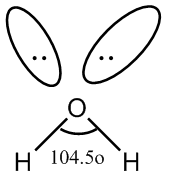
The bond angle in a water molecule is nearly or directed bonds in water forms an angle of
A) \[120^\circ {\rm{C}}\]
B) \[180^\circ {\rm{C}}\]
C) \[109^\circ 28\]
D) \[104^\circ 30\]
Answer
225k+ views
Hint: The molecule of water has two bond pairs and two lone pairs. Therefore, the geometry of the molecule is tetrahedral in nature. Here, we will use the VSEPR theory to predict the bond angle.
Complete Step by Step Answer:
Let’s discuss the type of bond formed by the oxygen molecule of water. In the molecule of water, an oxygen atom is bonded to two oxygen atoms. The covalent bond formed between oxygen and hydrogen atoms is polar because of higher difference in electronegativity of these two atoms. So, there are two bond pairs of the oxygen atom. Also, there are two lone pairs of oxygen atoms. So, the two bond pairs and lone pairs are arranged in the tetrahedral geometry around the central atom.
We know, the bond angle in a tetrahedral molecule is \[109.5^\circ C\] . In case of water, due to the repulsion of two lone pairs and repulsion of lone pair and bond pair, the decrease of bond angle from \[109.5^\circ C\]to \[104.5^\circ C\]which is approximate to \[105^\circ {\rm{C}}\] .
Now, we will draw the structure of the water molecule.

Image: Molecule of water
So, we see that the molecule of water has a bent shape.
Therefore, option D is right.
Note: The VSEPR theory based on the lone pairs and bond pairs around the central atom predicts the shape of molecules. According to this theory, the repulsion is highest in case of two lone pairs and lowest in case of two bond pairs and the repulsion of bond pair and lone pairs is between these two.
Complete Step by Step Answer:
Let’s discuss the type of bond formed by the oxygen molecule of water. In the molecule of water, an oxygen atom is bonded to two oxygen atoms. The covalent bond formed between oxygen and hydrogen atoms is polar because of higher difference in electronegativity of these two atoms. So, there are two bond pairs of the oxygen atom. Also, there are two lone pairs of oxygen atoms. So, the two bond pairs and lone pairs are arranged in the tetrahedral geometry around the central atom.
We know, the bond angle in a tetrahedral molecule is \[109.5^\circ C\] . In case of water, due to the repulsion of two lone pairs and repulsion of lone pair and bond pair, the decrease of bond angle from \[109.5^\circ C\]to \[104.5^\circ C\]which is approximate to \[105^\circ {\rm{C}}\] .
Now, we will draw the structure of the water molecule.

Image: Molecule of water
So, we see that the molecule of water has a bent shape.
Therefore, option D is right.
Note: The VSEPR theory based on the lone pairs and bond pairs around the central atom predicts the shape of molecules. According to this theory, the repulsion is highest in case of two lone pairs and lowest in case of two bond pairs and the repulsion of bond pair and lone pairs is between these two.
Recently Updated Pages
JEE Main 2025-26 Mock Test: Organic Compounds Containing Nitrogen

JEE Main 2025-26 Organic Compounds Containing Nitrogen Mock Test

JEE Main Chemical Kinetics Mock Test 2025-26: Free Practice Online

JEE Main 2025-26 Organic Compounds Containing Oxygen Mock Test

JEE Main 2025-26 Organic Compounds Containing Halogens Mock Test

Sodium acetate on heating with soda lime produce A class 12 chemistry JEE_Main

Trending doubts
JEE Main 2026: City Intimation Slip and Exam Dates Released, Application Form Closed, Syllabus & Eligibility

JEE Main 2026 Application Login: Direct Link, Registration, Form Fill, and Steps

Understanding the Angle of Deviation in a Prism

Hybridisation in Chemistry – Concept, Types & Applications

How to Convert a Galvanometer into an Ammeter or Voltmeter

Ideal and Non-Ideal Solutions Explained for Class 12 Chemistry

Other Pages
NCERT Solutions For Class 12 Chemistry Chapter 1 Solutions - 2025-26

JEE Advanced Marks vs Ranks 2025: Understanding Category-wise Qualifying Marks and Previous Year Cut-offs

Solutions Class 12 Chemistry Chapter 1 CBSE Notes - 2025-26

NCERT Solutions ForClass 12 Chemistry Chapter Chapter 4 The D and F Block Elements

Biomolecules Class 12 Chemistry Chapter 10 CBSE Notes - 2025-26

NCERT Solutions For Class 12 Chemistry Chapter 10 Biomolecules - 2025-26




